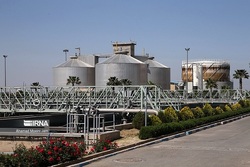
‘Biogas plants required to generate power in wastewater treatment plants’

Abbas-Ali Mesr-Zadeh made the remarks referring to the construction of the biogas power plant of units 5 and 6 of South Tehran Wastewater Treatment Plant, which was put into operation in the presence of Energy Minister Ali-Akbar Mehrabian on Tuesday morning.
This power plant has the possibility of generating 15 million kilowatt hours of electricity with two combined heat and power (CHP) generators with a total nominal capacity of 2.4 megawatt hours.
Implementation of this project results in the reduction of greenhouse gas emissions by about 75,000 tons of carbon dioxide annually.
In this power plant, in addition to collecting the biogas from wastewater treatment and preventing its release, by generating electricity and heat from it and avoiding the consumption of fossil fuel to generate the required energy, the production and release of methane gas will also be prevented.
A biogas plant is a facility that provides oxygen-free conditions where anaerobic digestion can occur. Simply put, it's an artificial system where you can turn waste into sustainable energy and fertilizers, with positive effects on the environment.
Combined heat and power (CHP), also known as cogeneration, is the concurrent generation of electricity or mechanical power and useful thermal energy (heating and/or cooling) from a single source of energy.
According to Mesr-Zadeh, the first urban wastewater biomass power plant was opened in Tehran in the same treatment plant in the Iranian calendar year 1389 (March 2010-March 2011).
Source: Tehran Times


Trump weighs using $2 billion in CHIPS Act funding for critical minerals

Codelco cuts 2025 copper forecast after El Teniente mine collapse

Electra converts debt, launches $30M raise to jumpstart stalled cobalt refinery

Barrick’s Reko Diq in line for $410M ADB backing

Abcourt readies Sleeping Giant mill to pour first gold since 2014

Nevada army depot to serve as base for first US strategic minerals stockpile

SQM boosts lithium supply plans as prices flick higher

Viridis unveils 200Mt initial reserve for Brazil rare earth project

Tailings could meet much of US critical mineral demand – study

Kyrgyzstan kicks off underground gold mining at Kumtor

Kyrgyzstan kicks off underground gold mining at Kumtor

KoBold Metals granted lithium exploration rights in Congo

Freeport Indonesia to wrap up Gresik plant repairs by early September

Energy Fuels soars on Vulcan Elements partnership

Northern Dynasty sticks to proposal in battle to lift Pebble mine veto

Giustra-backed mining firm teams up with informal miners in Colombia

Critical Metals signs agreement to supply rare earth to US government-funded facility

China extends rare earth controls to imported material

Galan Lithium proceeds with $13M financing for Argentina project

Kyrgyzstan kicks off underground gold mining at Kumtor

Freeport Indonesia to wrap up Gresik plant repairs by early September

Energy Fuels soars on Vulcan Elements partnership

Northern Dynasty sticks to proposal in battle to lift Pebble mine veto

Giustra-backed mining firm teams up with informal miners in Colombia

Critical Metals signs agreement to supply rare earth to US government-funded facility

China extends rare earth controls to imported material

Galan Lithium proceeds with $13M financing for Argentina project

Silver price touches $39 as market weighs rate cut outlook

















